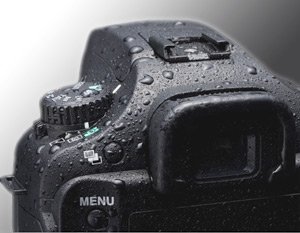Weather-Sealed DSLR Camera Comparison

NOTEClick here for a comparison of weather-sealed mirrorless digital cameras.
Weather-sealed DSLR cameras allow photographers to reach for outstanding image quality and versatility under almost any weather condition. While most full-frame DSLRs feature some form of weather-sealing, there are only six such cameras that can be had for under $1700 USD, about half the price of a full-frame model.
This article compares all the affordable weather-sealed DSLR cameras in production. These DSLRs are the Canon EOS 7D, the Nikon D300S, the Olympus E-3, the Pentax K-7, the Pentax K20D and the Pentax K200D. The definition of weather-sealed varies between models but does not mean waterproof, so all DSLRs require a special housing for under-water use.
Weather-sealed bodies require weather-sealed lenses for the whole to be weather-sealed. With the exception of the Pentax K200D, weather-sealed DSLRs are high-end models with lots of buttons and dual control-wheels. Outside of very few Pentax WR lenses, weather-sealed lenses are relatively expensive and contribute considerably to the total cost of a such a DSLR system.
| Table 1 - Model Prices | |||
|---|---|---|---|
| Brand | Camera | Recent Street Price | |
| Canon | EOS 7D | 1699 USD | 1949 CDN |
| Nikon | D300S | 1499 USD | 1549 CDN |
| Olympus | E-3 | 1060 USD | 1488 CDN |
| Pentax | K-7 | 1050 USD | 1469 CDN |
| Pentax | K20D | 799 USD | 875 CDN |
| Pentax | K200D | 599 USD | 514 CDN |
It is pure coincidence that the alphabetical ordering of these cameras coincide to ordering from the most expensive to the least. The above prices show a clear grouping of the higher end models which all feature a 100% viewfinder. The K200D as the cheapest weather-sealed DSLR should be of great interest to those who do not need all the pro features, while the K20D is an excellent value with most pro features at a price close to the K200D.
The prices above were found at the time of publication based on availability and usually good down over time. They are only quoted for the body, no lens or memory card is included, so do leave room in your budget to complete the system. Remember that the lens is an important aspect of DSLR image quality and should be given careful consideration. Check the lens buying guide for more information on how to choose lenses.
Among these, there is no truly wrong camera. Any choice is capable of producing excellent photographs for all types of photographic subjects. Therefore, if one simply chooses the least expensive one, it would be certainly a wise choice. No need to read so many reviews, time is saved and money is saved. The money saved can be spent on better lenses. A simple choice with simple benefits.
As all DSLRs, the models here all feature interchangeable lenses, high-ISO capabilities, optical reflex viewfinders, full manual controls, custom white-balance, shutter-speeds for action and low-light, continuous drives and a hot-shoe. All these models can reach to ISO 3200 or more with shutter-speeds at least as fast as 1/4000s and at least as slow as 30s. Continuous drive modes of 2.8 FPS or more are available on all these cameras. Also, these models all feature a built-in flash. Their common features are listed in table 2.
Deal seakers may be interested to know that there are older models which may still be available new from some stores and mostly likely on sale wherever you can buy used cameras. The Nikon D300 shares the same sensor and nearly identical body as the D300S except that it lacks video-recording, dual memory card slots and a virtual horizon. A few other features differ slightly, for example the D300S can shoot at 7 FPS while the D300 reaches 6 FPS. The Pentax K10D is nearly identical to the K20D, except with a 10 megapixels sensor capabel of ISO 1600 instead of the K20D's 14 megapixels sensor which can reach ISO 6400. The K20D also adds several advanced features like LCD color-calibration, dust-alert, dynamic-range expansion and a slightly larger LCD.
Now that it is clear that these DSLR cameras have all the fundamental features we expect from such modern digital cameras, we examine their major differences on page 2. In deciding among one of these cameras, major differences relevant to your photographic needs should be considered first. Should no major differences affect your photographic needs, then it will come down do minor differences. Minor differences are described starting on page 3.
Table 2 - Weather-Sealed DSLRs Common Features |
 |
|||
| Interchangeable lenses | 1.5X, 1.6X or 2X crop factor | PASMProgram, Aperture-Priority, Shutter-Priority, Manual modes with shift | Depth-of-field preview | |
| Evaluative, center weighed and spot metering | Single autofocus Continuous autofocus Manual focus |
Automatic focus-point Selected focus point Center focus-point |
Exposure or white-balance bracketing | |
| Shutter-speeds covering 1/4000s-30s, Bulb mode | Flash sync between 1/125 and 1/250 | 1/2 and 1/3 stops exposure increments | ISO range covering 100-3200 | |
| Auto, preset and custom white-balance | Control over saturation, sharpness and contrast | 2.8 FPS or faster continuous drive | Short and long self-timers | |
| Auto-review with magnify and histogram | 2.5" to 3" LCD, 230K or 920K Pixels | Pop-up flashGN between 11 and 13 @ ISO 100 and hot-shoe | CF Type II or SDHC memory | |
| Automatic Dust-Reduction | JPEG or RAW shooting | |||

